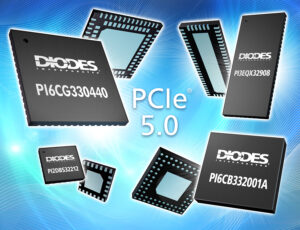Diodes Incorporated announced at the PCI-SIG Developers Conference in Santa Clara, CA, the introduction of a broad portfolio of products supporting the new PCI Express (PCIe) 5.0 protocol. This includes ReDriver, switch, clock generator, and clock buffer devices for use in portable and desktop computing, data centers, and high-performance computing (HPC) applications.
 At the forefront of this portfolio is the DIODES PI3EQX32908. Supporting the 32Gbps data rates defined by PCIe 5.0 specification, this ReDriver has eight differential channels with independent channel configuration. Linear equalization, output swing, and flat gain parameters are programmable, so the signal loss issues can be minimized and PCB trace lengths extended.
At the forefront of this portfolio is the DIODES PI3EQX32908. Supporting the 32Gbps data rates defined by PCIe 5.0 specification, this ReDriver has eight differential channels with independent channel configuration. Linear equalization, output swing, and flat gain parameters are programmable, so the signal loss issues can be minimized and PCB trace lengths extended.
In line with Modern Standby requirements, this device draws less than 5mW of power when the system in which it is incorporated is in deep standby mode. As well as PCIe 5.0 architecture, the ReDriver also supports SAS4 and CXL protocols.
Accompanying the PI3EQX32908 is the DIODES PI2DBS32212, which is one of the industry’s first PCIe 5.0 switches. The bidirectional operation of this two-differential channel device offers 2:1 passive Mux and DeMux functionality. With its unique design, this switch has dynamic electrical characteristics that minimize signal attenuation.
Bit-to-bit skew is 3ps (typical) while channel-to-channel skew is only 10ps (typical). When operating at 16GHz, both insertion and return losses remain very low, at -2.7dB and -10.8dB respectively. Its 1.8V supply voltage and compact size make this switch highly suited for use in portable electronic equipment. The PI2DBS32212 is also compatible with USB4 Gen 2×1/Gen 3×1 and Thunderbolt™ 3 data signals.
Also, for emerging PCIe technology applications, there’s the DIODES PI6CG330440, a PCIe 5.0 19-output clock generator. This takes a reference input and generates 25MHz and 100MHz frequency outputs. It has seven outputs dedicated to 100MHz and three dedicated to 25MHz clock signals. The remaining nine selectable outputs can drive 25 or 100MHz, as required. The proprietary design used achieves low jitter performance of less than 50fs.
The DIODES PI6CB332001A, is a 20-output fan-out PCIe 5.0 clock buffer that meets the Intel DB2000QL specification. When operating at PCIe 5.0 architecture speeds, this device exhibits minimal additive phase jitter — 20fs RMS is typical. This gives engineers wider signal integrity margins for their designs.
The on-chip termination on the outputs of the PI6CG330440 and the PI6CB332001A results in far fewer external components required, saving board space. Because of their respective Intel CK440Q and Intel DB2000QL compatibility, they present higher performance drop-in replacements for other clock generator/buffers targeted at server applications.
“Diodes Incorporated is a valued member of the PCI-SIG and continues to contribute to the progression of PCIe technology within the electronic engineering community,” said Al Yanes, PCI-SIG President and Chairperson. “Through the semiconductor solutions it introduces, the company is helping the latest generations of PCIe technology gain greater pervasiveness within the market.”
“Emergence of the PCIe 5.0 specification offers the prospect of doubling the bandwidth available, and this will be hugely beneficial in all forms of computing equipment and data storage infrastructure,” adds Dr. Jin Zhao, senior VP, Analog Business Group, Diodes Incorporated. “As speeds increase, access to technology that will ensure signal integrity and mitigate losses is becoming more important than ever. Diodes has made a major commitment to supporting PCIe technology, releasing innovative products to address each protocol generation that has emerged. Our new PCIe 5.0 product portfolio continues to build on this strong track record.”
Those attending the PCI-SIG Developers Conference 2022 (June 21-22, Santa Clara Convention Center, Santa Clara, California) can find Diodes at Booth 8.
Filed Under: Components, News, Power Management


Questions related to this article?
👉Ask and discuss on Electro-Tech-Online.com and EDAboard.com forums.
Tell Us What You Think!!
You must be logged in to post a comment.